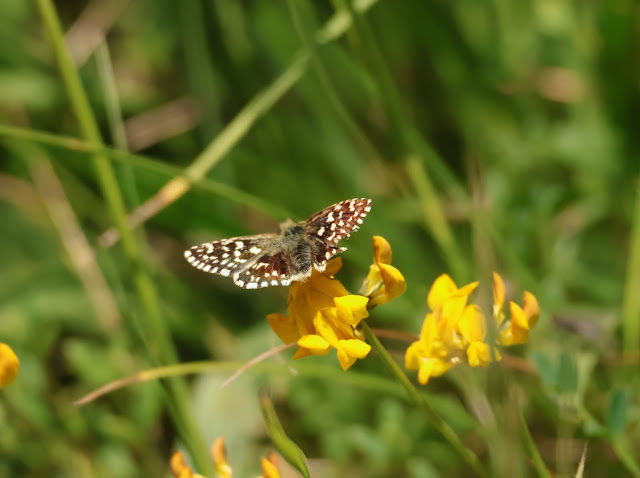The rspb reserve at Bempton Cliffs on the Yorkshire coast is a place I've wanted to visit for long time due to the vast numbers of sea birds that nest there including everyone's favourite - puffins.
So when my sister casually suggested that maybe we should both stay there for a night or two I jumped at the chance. Half term would be a perfect time of year so we booked some accommodation and I also bought tickets for a boat trip which would take us out to see the birds from the sea below the cliffs
After an early start with a stop off at Far Ings nature reserve near the Humber bridge, we arrived at Bridlington and took the park and ride bus down to the harbour in good time and explored for a while before heading for the Yorkshire Belle which was moored against the pier. We were first in the queue and therefore able to choose the seats that we wanted, in this case on the side nearest the cliffs on the outward journey and with the best protection from the rain which was forecast and had already started to fall! We opted to stay outside rather than under cover in order to get better views and were glad we did. As the boat passed Flamborough head, we could see sea birds all around, including gannets, razor bills, guillemots, kittiwakes and a few puffins, either on the water or flying to and from the cliffs as they paired up and collected nesting material. We even saw a 'bridled' guillemot amongst them and an occasional seal popped its head out of the water. The cliffs were impressive with the huge numbers of nesting birds and the resultant noise. Every now and then the rain would get harder and I had to keep hiding my camera under my coat between shots and wiping it after use. Nevertheless the boat trip gave us the opportunity to see just how many birds were there, something we could never see from the top of the cliffs and as we returned to our accommodation at nearby Flamborough, there was plenty to muse on.
Next morning the weather had improved and by 7.40 a.m. we were at Bempton Cliffs carpark in brilliant sunshine, before the visitor centre opened. We made our way out to to the cliff top, passing through a flower strewn meadow, with sedge warblers and whitethroats singing from the hedges and tree sparrows frequenting some feeders. As we approached the cliff path and the first viewing platform, the noise of seabirds became louder and, peering over the cliffs; we could see many razorbills and guillemots nesting on the ledges together with good numbers of kittiwakes. Taking the path to the left we followed the edge of the cliff, gannets could be seen circling out at sea, then returning to the cliffs. They were pulling grass from the top of the cliffs only a few metres away and flew almost at eye level before coming into land. I took far too many photos, experimenting with different flight shots. At the final platform we eventually came across a couple of puffins, although they were quite distant and difficult to photograph even for a record shot.
After concluding that we had had our fill of seabirds for the morning we set off on a drive which would take us north over the Yorkshire Moors. We took a route that my sister suggested, as she had been before, which would lead us to Danby where there was a tea room. She assured me that we would see red grouse on the way and it wasn't too long before we did, a small head poking above the bracken. Slowing down we saw a female too but they disappeared behind a hump and we continued on.
Suddenly we heard the familiar call of a curlew, another bird of the moors, but when we stopped on the side of the road it started to run towards us .. it was then we realised that we had stopped just in front of where its young were hiding! We moved on a bit and found another bird which posed nicely for us on top of a mound, calling.
A few more grouse could be seen as we made our way slowly along the road which had open views all around. The flowering heather looked as if it had gone over, as it was more brown than purple. I thought how pretty it would look when the moors were covered in purple heather. We also saw some grouse chicks with a few female birds.
After refreshing ourselves at Danby we drove back down to Pickering- a quick walk at Fen Bog failed to turn up the hoped for Large heath and Small Pearl bordered fritillaries - probably too early in the season, but I did find my first small copper butterfly of the year.
After eating back at Flamborough we decided to make the most of the light evening, and drove out to Flamborough Head. We parked by the lighthouse, and spoke to some other visitors who told us they hadn't seen puffins but there were plenty of seals and we soon found these hidden down on a beach. I had heard that this would be a good place to try to see puffins and despite what we had been told, we found three of them in a good position to photograph on the edge of the cliffs. I lay down to get a better view and to eliminate any risk of standing too near the edge! After a while the sun began to sink, and we returned to our cottage, delighted to have at last had some good views of puffins.

nesting kittiwakes at Bridlington
kittiwakes

guillemot
'bridled' guillemot
razorbills and guillemots
tree sparrow near Bempton cliff feeders
gannets near the cliff top



























































